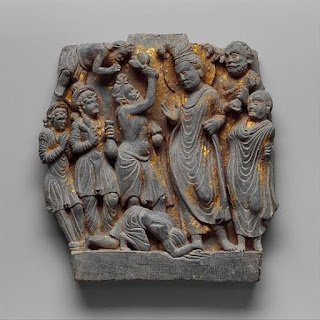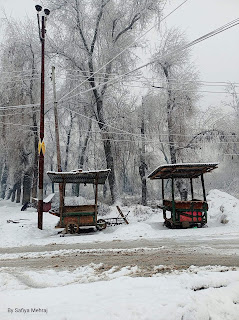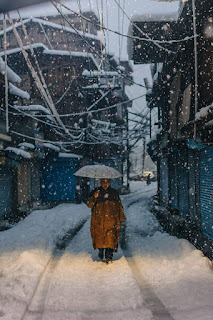RAM NIRANJAN NYAARA RE......KABIR
( The untainted Nirguna Brahman is Unique )
Niranjan is better understood as opposite of Anjan or dusky or dark or tainted. Ram here means the Nirgun Brahman or the untainted reality. According to Adi Sankara , the doyen of Advaita Vedanta, and the proponent of Impersonalism, Brahman is viewed from 3 different epistemic perspectives :-
(1)An absolute point of view Brahman is free from every conceivable limiting factor .It is beyond human conceptions ,inconceivable and inexpressible and is therefore Nirguṇa.
(2) A practical existential point of view ,as the manifest universe, Brahman appears to embody the qualities of nature - the three primary qualities of nature (prakṛti) are inertia or static energy (tamas), the dynamic or kinetic energy (rajas) and the harmonising or integrating energy (sattva).
(3) A nescient point of view (adhyasa) ,what we perceive as reality is falsely superimposed onto Brahman the substrata of Being. The classical example used is the example of the rope and the snake. In a dimly lit place, a coiled up rope appears as a snake and causes the adrenaline reaction of fright and flight. But when a light is shone on the thing it appears as a rope only and the fear and anxiety dissipate giving way to nervous laughter and relief. So the Universe that we are experiencing is likewise a product of our nescience.
According to Ramanuja , Brahman as Nirguṇa is absolutely free from all negative conception, connotations and qualities such as; delusion, ignorance, arrogance, anger, hate, vindictiveness, revenge, maliciousness, wilfulness ,etc. When speaking of Brahman as Saguṇa - he means that Brahman is replete with all positive qualities imaginable - giving examples such as, sarva-bhuta-suhṛt ( the friend of all beings),Parama-udara( the all- bountiful one), Sulabha ( easily accessible to all beings),Daya-sagara ( the ocean of mercy ) ,Vatsalya ( full of tenderness and affection),Saumya(approachable by all beings irrespective of their socio-psycho-physical differences or stages of evolution), karuṇya( the one with infinite and unlimited and unconditioned compassion), audarya ( the one who is extremely generous to every creature ) and many more. By allowing the urge for devotional worship (Bhakti ) into his doctrine of salvation, he aligned the Hindu religion with the pursuits of philosophy and gave Bhakti an intellectual basis.Ramanuja transformed the practice of ritual action into the practice of divine worship and the way of meditation into a continuous loving and pondering of God’s qualities, both in turn a subservient to Bhakti, the fully realized devotion that brings the devotee close to the Brahman or supreme reality. Kabir is profoundly influenced by Ramanuja .
So Saguna and Nirguna Brahman are two sides of the same coin. The same thing viewed under different conditions and variables appears with different characteristics. According to Kabir, the merchants of religion have become custodians of Saguna. With greed , they have tainted the name of Saguna Brahman and induced fear . Everything has been polluted by them except the Nirguna Brahman or the untainted and unblemished reality. Kabir is never against scriptures .He says :-
"Ved Kitab juthe na Bhai,
Juthe voh jo samjhe nahi.”
,( The Vedas , the scriptures are not wrong. wrong are the people who couldn't understand them.)
Kabir had been one of the many disciples of the Bhakti poet-saint Swami Ramananda in Varanasi, known for devotional Vaishnavism with a strong bent to monist Advaita philosophy teaching that God was inside every person and everything. However , Kabir refuses to surrender to the merchants of Saguna . Accordingly , fearless he choses Nirguna path and sings in praise of the untainted , the one who according to him, is beyond the reach of the custodians of the religion . In one of his famous Bhajans, Kabir says this:-
" Nirbhaiy Nirgun gun re gaunga re
gaunga Nirbhay Nirgun
Ingala Pingala Sukhman *Nadi-ji
Tirveni Pe Haun Nahaunga"
(Fearlessly I will sing the attributes of the one without attributes,
Ingila, Pingala and Sukhman are the Channels,
I will bathe at the confluence of the three rivers.)
Coming to the main Nirguna Bhajan :
"Ram Niranjan Nyaara Re,
Anjan Sakal Pasaara Re
Anjan Utapati, Omkar,
Anjan Mange Sab Bistar
Anjan Brahma Shankar Inder
Anjan Gopi Sangi Govind Re
Anjan Vani, Anjan Ved,
Anjan Kiya Na Na Bhed
Anjan Vidya Path Puran,
Anjan Woh Kat Kat Hi Gyan Re
Anjan Paati Anjan Dev,
Anjan Ki Kare Anjan Sev
Anjan Nache Anjan Gawe,
Anjan Bhesh Anant Dikhawe Re
Anjan Kahan Kahan Lag Keta,
Daan Punya Tap Tirath Jeta
Kahe Kabir Koi Birla Jage,
Anjan Chaadhi Anant Hi Dage Re"
(Kabir)
I understand this Nirguna Bhajan this way....
(Matchless remains my Nirguna Rama ,
the unblemished/ spotless one ,
The Nirguna Brahman , the only pure
and untainted in the
spread of the blemished and tainted around us.
We polluted the creation's womb ,
Omkar too , we tainted;
And now this pollution demands expansion in every sphere.
The Brahma ,Shankara, Indira,Govinda and his Gopis,
We blemished them all.
We polluted the spoken words,
we polluted the listening as well.
This blemished conduct
created too many distinctions .
The knowledge,
the prayers,
the scriptures ,
our questions,
our reasoning,
everything we polluted.
The green leaves,
the enlightened beings,
the master,
the servant,
the singer,
the dancer,
this tainted now exists in limitless or infinite shapes and forms.
There is hardly any place in this world
where this polluted hasn't manifested itself .
In the philanthropy,
In our austerities,
and in our pilgrimages,
the polluted has become victorious in every field.
Says Kabir ,only some exceptional individual lies awakened ,
Otherwise the blemished has left his imprints everywhere in every creature.)
About Kabir , Gurudev Tagore writes this :-
"Kabir belongs to that small group of supreme mystics— amongst whom St. Augustine, Ruysbroeck, and the Sufi poet Jalalu’ddin Rumi are perhaps the chief—who have achieved that which we might call the synthetic vision of God. These have resolved the perpetual opposition between the personal and impersonal, the transcendent and immanent, static and dynamic aspects of the Divine Nature; between the Absolute of philosophy and the “sure true Friend” of devotional religion. They have done this, not by taking these apparently incompatible concepts one after the other; but by ascending to a height of spiritual intuition at which they are, as Ruysbroeck said, “melted and merged in the Unity,” and perceived as the completing opposites of a perfect Whole."
(Avtar Mota)
PS
*RAM NIRANJAN NYAARA RE......KABIR
( The untainted Nirguna Brahman is Unique )
Niranjan is better understood as opposite of Anjan or dusky or dark or tainted. Ram here means the Nirgun Brahman or the untainted reality. According to Adi Sankara , the doyen of Advaita Vedanta, and the proponent of Impersonalism, Brahman is viewed from 3 different epistemic perspectives :-
(1)An absolute point of view Brahman is free from every conceivable limiting factor .It is beyond human conceptions ,inconceivable and inexpressible and is therefore Nirguṇa.
(2) A practical existential point of view ,as the manifest universe, Brahman appears to embody the qualities of nature - the three primary qualities of nature (prakṛti) are inertia or static energy (tamas), the dynamic or kinetic energy (rajas) and the harmonising or integrating energy (sattva).
(3) A nescient point of view (adhyasa) ,what we perceive as reality is falsely superimposed onto Brahman the substrata of Being. The classical example used is the example of the rope and the snake. In a dimly lit place, a coiled up rope appears as a snake and causes the adrenaline reaction of fright and flight. But when a light is shone on the thing it appears as a rope only and the fear and anxiety dissipate giving way to nervous laughter and relief. So the Universe that we are experiencing is likewise a product of our nescience.
According to Ramanuja , Brahman as Nirguṇa is absolutely free from all negative conception, connotations and qualities such as; delusion, ignorance, arrogance, anger, hate, vindictiveness, revenge, maliciousness, wilfulness ,etc. When speaking of Brahman as Saguṇa - he means that Brahman is replete with all positive qualities imaginable - giving examples such as, sarva-bhuta-suhṛt ( the friend of all beings),Parama-udara( the all- bountiful one), Sulabha ( easily accessible to all beings),Daya-sagara ( the ocean of mercy ) ,Vatsalya ( full of tenderness and affection),Saumya(approachable by all beings irrespective of their socio-psycho-physical differences or stages of evolution), karuṇya( the one with infinite and unlimited and unconditioned compassion), audarya ( the one who is extremely generous to every creature ) and many more. By allowing the urge for devotional worship (Bhakti ) into his doctrine of salvation, he aligned the Hindu religion with the pursuits of philosophy and gave Bhakti an intellectual basis.Ramanuja transformed the practice of ritual action into the practice of divine worship and the way of meditation into a continuous loving and pondering of God’s qualities, both in turn a subservient to Bhakti, the fully realized devotion that brings the devotee close to the Brahman or supreme reality. Kabir is profoundly influenced by Ramanuja .
So Saguna and Nirguna Brahman are two sides of the same coin. The same thing viewed under different conditions and variables appears with different characteristics. According to Kabir, the merchants of religion have become custodians of Saguna. With greed , they have tainted the name of Saguna Brahman and induced fear . Everything has been polluted by them except the Nirguna Brahman or the untainted and unblemished reality. Kabir is never against scriptures .He says :-
"Ved Kitab juthe na Bhai,
Juthe voh jo samjhe nahi.”
,( The Vedas , the scriptures are not wrong. wrong are the people who couldn't understand them.)
Kabir had been one of the many disciples of the Bhakti poet-saint Swami Ramananda in Varanasi, known for devotional Vaishnavism with a strong bent to monist Advaita philosophy teaching that God was inside every person and everything. However , Kabir refuses to surrender to the merchants of Saguna . Accordingly , fearless he choses Nirguna path and sings in praise of the untainted , the one who according to him, is beyond the reach of the custodians of the religion . In one of his famous Bhajans, Kabir says this:-
" Nirbhaiy Nirgun gun re gaunga re
gaunga Nirbhay Nirgun
Ingala Pingala Sukhman *Nadi-ji
Tirveni Pe Haun Nahaunga"
(Fearlessly I will sing the attributes of the one without attributes,
Ingila, Pingala and Sukhman are the Channels,
I will bathe at the confluence of the three rivers.)
Coming to the main Nirguna Bhajan :
"Ram Niranjan Nyaara Re,
Anjan Sakal Pasaara Re
Anjan Utapati, Omkar,
Anjan Mange Sab Bistar
Anjan Brahma Shankar Inder
Anjan Gopi Sangi Govind Re
Anjan Vani, Anjan Ved,
Anjan Kiya Na Na Bhed
Anjan Vidya Path Puran,
Anjan Woh Kat Kat Hi Gyan Re
Anjan Paati Anjan Dev,
Anjan Ki Kare Anjan Sev
Anjan Nache Anjan Gawe,
Anjan Bhesh Anant Dikhawe Re
Anjan Kahan Kahan Lag Keta,
Daan Punya Tap Tirath Jeta
Kahe Kabir Koi Birla Jage,
Anjan Chaadhi Anant Hi Dage Re"
(Kabir)
I understand this Nirguna Bhajan this way....
(Matchless remains my Nirguna Rama ,
the unblemished/ spotless one ,
The Nirguna Brahman , the only pure
and untainted in the spread of the tainted and the blemished around us.
We polluted the creation's womb ,
Omkar too , we tainted;
And now this pollution demands expansion in every sphere.
The Brahma ,Shankara, Indira,Govinda and his Gopis,
We blemished them all.
We polluted the spoken words,
we polluted the listening as well.
This blemished conduct
created too many distinctions .
The knowledge,
the prayers,
the scriptures ,
our questions,
our reasoning,
everything we polluted.
The green leaves,
the enlightened beings,
the master,
the servant,
the singer,
the dancer,
this tainted now exists in limitless or infinite shapes and forms.
There is hardly any place in this world
where this polluted hasn't manifested itself .
In the philanthropy,
In our austerities,
and in our pilgrimages,
the polluted has become victorious in every field.
Says Kabir ,only some exceptional individual lies awakened ,
Otherwise the blemished has left his imprints everywhere in every creature.)
About Kabir , Gurudev Tagore writes this :-
"Kabir belongs to that small group of supreme mystics— amongst whom St. Augustine, Ruysbroeck, and the Sufi poet Jalalu’ddin Rumi are perhaps the chief—who have achieved that which we might call the synthetic vision of God. These have resolved the perpetual opposition between the personal and impersonal, the transcendent and immanent, static and dynamic aspects of the Divine Nature; between the Absolute of philosophy and the “sure true Friend” of devotional religion. They have done this, not by taking these apparently incompatible concepts one after the other; but by ascending to a height of spiritual intuition at which they are, as Ruysbroeck said, “melted and merged in the Unity,” and perceived as the completing opposites of a perfect Whole."
(Avtar Mota)
PS
The three principal nadis run from the base of the spine to the head, and are the ida on the left, the sushumna in the centre, and the pingala on the right. Ultimately the goal is to unblock these nadis to bring liberation.Sushumna nadi is also called Brahmanadi, or the channel of the Absolute (Brahman). Some refer to it as the saraswati (wisdom) or shanti (peace) nadi. Kabir calls them three rivers or channels for the spiritual bath .
 CHINAR SHADE
CHINAR SHADE by
Autarmota is licensed under a
Creative Commons Attribution-Noncommercial-No Derivative Works 2.5 India License.
Based on a work at
http:\\autarmota.blogspot.com\.














































































